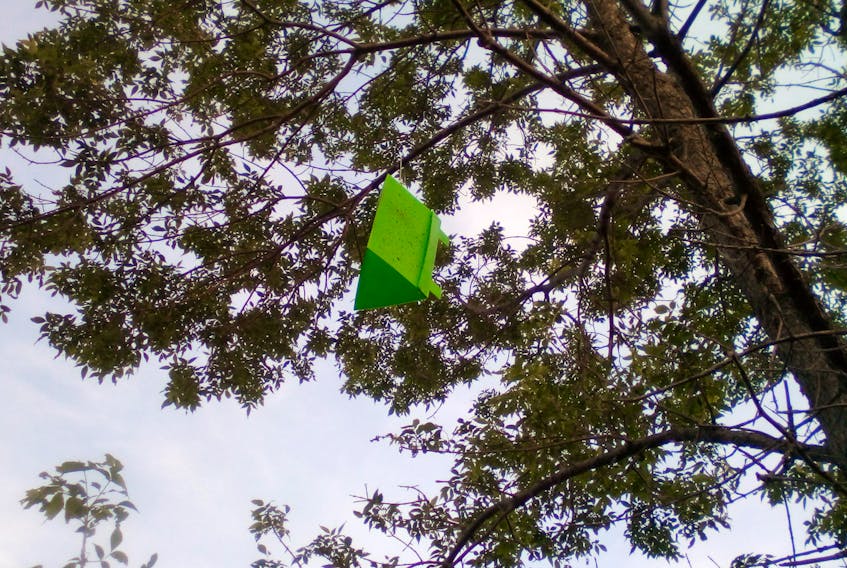TRURO, N.S.
At a glance, they appear simply as a small green, triangular box hanging in a tree.
But at their core, they are a first line of defence – or at least detection – against an invasive, voracious beetle whose kind have destroyed hundreds of millions of ash trees across North America.
And while the emerald ash borer has yet to be discovered in Nova Scotia, the threat of its arrival is a stark reality.
“It’s a pest that’s been spreading quite quickly across North America,” said Ron Neville, a plant health survey biologist with the Canadian Food Inspection Agency (CFIA). “And it certainly threatens our ash trees, both in the urban environment and also in our forest areas as well.”
The green boxes are designed to trap the beetles so their presence can be detected as early as possible if and when they do arrive in the province. CFIA inspectors, in collaboration with Town of Truro staff, have placed five of the traps in various areas around town, including Victoria Park and at the Kiwanis Pond on Robie Street.

And while there is some risk of the beetles arriving in Nova Scotia inside the wood of a shipping pallet, Neville said their primary mode of transportation is when travelers or campers from Ontario or Quebec bring their own infested firewood into this province.
“The main way that it’s being spread is people moving infested materials from areas that are infested to areas that are not. That’s one of our main concerns,” he said. “We advise campers and travelers to buy their firewood locally. To buy it where they burn it.”
Detecting whether a piece of wood is infested with the beetle is difficult because they live underneath the bark.
And while the pests will naturally migrate a few kilometres per year, they can easily be transported hundreds of kilometres per day by people.
“So, that’s essentially the risk that we have,” Neville said. “Early detection is challenging with the emerald ash borer. It tends to attack the crown of trees first. So, what we look for, is we set traps in the crowns of trees but we also look for declining crowns, yellowing leaves. We look for wood pecker activity in trees and we also look for d-shaped exit holes in trees.”
The CFIA’s goal is to find the beetle populations as soon as possible. Because, early detection is so difficult, however, they can sometimes be present in a given area for a few years before it is identified, Neville said.
And, by that time, a lot of damage can already be done.
“More commonly we see evidence of attack after a few years of an attack in a tree,” Neville said. “They can kill trees in five or less years when populations are high.”
The main ash trees in Nova Scotia are white and black (which is an endangered species). But all native ash trees in the Maritimes as well as those species that have been introduced through urban planning can serve as hosts.
Mountain ash trees do not serve as hosts for the emerald ash borer, however, because, botanically, they are not a true ash, he said.
FACTS:
- Emerald ash borers likely entered Canada in 2002, hitching rides on infested wooden pallets or other ash tree products from Asia;
- The beetle was first spotted in southern Ontario that same year in Windsor, as well as across the American border in Detroit;
- Since then, the beetle has spread across the country and is now menacing the Maritimes;
- In May, the beetle was discovered in Edmundston, N.B., the closest sighting so far to Nova Scotia;
- The beetle attacks ash trees when its larvae tunnel through the tree's vascular system that delivers water, nutrients and sugar;
- While woodpeckers can feed on emerging beetles, they have no known natural enemy that can effectively control their population;
- Once infested, ash trees have a nearly 100-per-cent chance of dying and most do so in two to four years.









